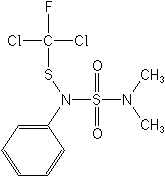-
Common NameDichlofluanid
-
中文通用名苯氟磺胺
-
IUPACN-dichlorofluoromethylthio-N′,N′-dimethyl-N-phenylsulfamide
-
CAS1,1-dichloro-N-[(dimethylamino)sulfonyl]-1-fluoro-N-phenylmethanesulfenamide
-
CAS No.1085-98-9
-
Molecular FormulaC9H11Cl2FN2O2S2
-
Molecular Structure
-
Category
-
ActivityFungicide
-
PremixPermethrin+dichlofluanid+tebuconazole
Dust, wettable powder, water dispersible granule. Premix Parters: amitrole diuron; 2,4-D; 2,4-D dicamba; 2,4-D mecoprop; 2,4-D mecoprop-P; dicamba ioxynil; ioxynil; ioxynil MCPA; MCPA mecoprop.
-
Physical PropertiesMolecular weight:333.2; Physical form:Colourless, odourless, crystalline powder. Melting point:106 °C; Vapour pressure:0.014 mPa (20 °C); Henry constant:3.6×10-3 Pa m3 mol-1 ( calc.); Partition coefficient(n-octanol and water):logP = 3.7 (21 °C); Solubility:In water 1.3 mg/l (20 °C). In dichloromethane >200, toluene 145, isopropanol 10.8, hexane 2.6 (all in g/l, 20 °C).; Stability:Decomposed by alkaline media; DT50 (22 °C) >15 d ( pH 4), >18 h ( pH 7), <10 min ( pH 9), and by polysulfides. Sensitive to light. Moderately soluble in organic solvents.
-
ToxicologyOral:Acute oral
LD50 for rats >5000 mg/kg. Percutaneous:Acute percutaneous LD50 for rats >5000 mg/kg. Slight skin irritant; moderate eye irritant (rabbits). Skin sensitiser. Inhalation: LC50 (4 h) for rats c. 1.2 mg/l air (dust), >0.3 mg/l (aerosol). Phytotoxicity:Some stone fruits and ornamentals may suffer slight injury. ADI:0.025 mg/kg b.w -
Environmental ProfileEcotoxicology:
Algae:ErC50 for Scenedesmus subspicatus 16 ml/l.Bees:Not toxic to bees.Birds:Acute oral LD50 for Japanese quail >5000 mg/kg. Daphnia: LC50 (48 h) >1.8 mg/l (90% pre-mix).Fish: LC50 (96 h) for rainbow trout 0.01, golden orfe 0.12, bluegill sunfish 0.03 mg/l.Worms: LC50 for Eisenia foetida >890 mg/kg dry soil.
Environmental fate:
Animals:In rats, following oral administration, dichlofluanid is rapidly absorbed and excreted, mainly via the urine. There is no accumulation in organs and tissues. Dichlofluanid is metabolised to dimethylsulfanilide, which is further hydroxylated and/or demethySoil:Due to its instability in soil, dichlofluanid is not leached into deeper soil layers. The main metabolite (dimethylsulfanilide) is further degraded and, according to parent and aged leaching studies, is unlikely to leach into deeper soil layers.Plant:In plants, dichlofluanid is metabolised to dimethylsulfanilide, which is further demethylated and/or hydroxylated and conjugated.
WATER SOLUBILITY: 1.3 mg/l at 20° C. -
Transport InformationSignal Word:CAUTION; Hazard Class:III (Slightly hazardous)
Porduct NewsMore
Bayer develops alternative to glyphosate herbicide
Colombia’s Constitutional Court bans chlorpyrifos
ADAMA Canada moves forward with lambda-cyhalothrin sales for 2023
Mexico: Import of glyphosate drops from 16,500 tons to 8,200 tons
Glyphosate prices drop 30% in Argentina
One year extension of EU glyphosate approval failed to pass in the latest meeting
Palmer amaranth in two southern U.S. states now resistant to S-metolachlor

 0
0 Subscribe
Subscribe
